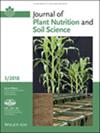Exploring the mechanisms of diverging mechanical and water stability in macro- and microaggregates
Abstract
Background
Soil stability is often evaluated using either mechanical or hydraulic stress. The few studies that use both approaches suggest that these two types of stability behave differently.
Aims
Our aim was to explore the mechanisms of aggregate stability regarding mechanical and water stability at the macro- and microscale, among other things, the effect of differing pore structure and soil organic matter content.
Methods
Samples were taken from two adjacent plots that were expected to differ in stability due to land use, that is, cropped versus bare fallow (BF). The stability of dry-separated macroaggregates (8–16 mm) and microaggregates (53–250 µm) was determined via wet sieving and unconfined uniaxial compression tests. To explore the mechanisms of stability, 3D pore characteristics were analyzed with microtomography scans. Furthermore, the contents of carbon and exchangeable polyvalent cations as well as contact angles were determined.
Results
Water stability of macroaggregates was much higher in the cropped plot (geometric mean diameter 0.65–2.37 mm [cropped] vs. 0.31–0.56 mm [BF]), while mechanical stability was very similar (median work 17.3 [cropped] and 17.5 N mm [BF]). The two size fractions behaved similarly regarding both types of stability, with more pronounced differences in macroaggregates. Several soil characteristics, like carbon, exchangeable calcium, and higher connectivity of pores to the aggregate exterior, contributed to water stability. Regarding mechanical stability, the destabilizing effect of lower carbon content and exchangeable calcium in the BF plot was counterbalanced by a lower porosity.
Conclusions
Mechanical and water stability behaved differently in the two plots due to the different deformation mechanisms.



 求助内容:
求助内容: 应助结果提醒方式:
应助结果提醒方式:


